Stanley Motor Carriage Company
 | |
| Industry | Automobile |
|---|---|
| Fate | Sold and dissolved |
| Founded | 1902 (first vehicle produced 1897) |
| Defunct | 1924 |
| Headquarters | Newton, Massachusetts, United States |
Key people | Francis Edgar Stanley and Freelan O. Stanley |
| Products | Vehicles |
The Stanley Motor Carriage Company was an American manufacturer of steam-engine vehicles; it operated from 1902 to 1924. The cars made by the company were colloquially called Stanley Steamers, although several different models were produced.
Early history

Twins Francis E. Stanley (1849–1918) and Freelan O. Stanley (1849–1940) founded the company after selling their photographic dry plate business to Eastman Kodak. They produced their first car in 1897. During 1898 and 1899, they produced and sold over 200 cars, more than any other U.S. maker.[1] In 1899, Freelan and his wife Flora drove one of their cars to the top of Mount Washington in New Hampshire,[2] the highest peak in the northeastern United States. The ascent took more than two hours and was notable as being the first time a car had climbed the 7.6 miles (12.2 km) long Mount Washington Carriage Road; the descent was accomplished by putting the engine in low gear and braking extensively. [2] The twins later sold the rights to this early design to Locomobile, and in 1902 they formed the Stanley Motor Carriage Company.
Specifications and design
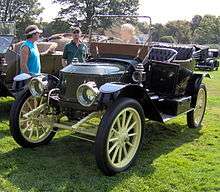
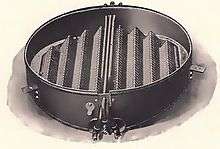
Early Stanley cars had light wooden bodies mounted on tubular steel frames by means of full-elliptic springs. Steam was generated in a vertical fire-tube boiler, mounted beneath the seat, with a vaporizing gasoline (later, kerosene) burner underneath. The boiler was reinforced by several layers of piano wire wound around it, which gave it a strong, yet relatively light-weight, shell. In early models, the vertical fire-tubes were made of copper, and were expanded into holes in the upper and lower crown sheets.[3] In later models, the installation of a condenser caused oil-fouling of the expansion joints, and welded steel fire-tubes were used instead. The boilers were safer than one might expect – they were fitted with safety valves, and even if these failed, a dangerous overpressure would rupture one of the many joints long before the boiler shell was in danger of bursting, and the resulting leak would relieve the boiler pressure and douse the burner with little risk to the occupants of the car. There has never been a documented case of a Stanley boiler exploding in use.
The engine had two double-acting cylinders side-by-side, equipped with slide-valves, and was of the simple-expansion type. Drive was transmitted directly from the engine crankshaft to a rear-mounted differential by means of a chain. Locomobiles were often modified by their owners, who added third-party accessories, e.g. improved lubricators, condensers, and devices which mitigated the laborious starting procedure, and so forth.
Later, the Stanley brothers, to overcome patent difficulties with the design they had sold to Locomobile, developed a new automobile model with twin-cylinder engines geared directly to the back axle. Later models had aluminium coachwork that resembled internal combustion cars of the time but retained the many steam-car features such as no transmission, clutch, or driveshaft. They also had a fully sprung tubular steel frame.
When they later shifted the steam boiler to the front of the vehicle, the resulting feature was called by owners the "coffin nose." The compact engine ran at considerable steam pressure, with the 10HP boiler described in 1912[4] at having the safety valve set at "650 pounds" (psi), with the burner set to automatically cut back when pressure reached "500 pounds". The twin cylinder steam engines were at that time 10HP, with 3.25inch bore and 4.25inch stroke, and 20HP with 4inch bore and 5inch stroke, and made extensive use of ball bearings. In order to improve range, condensers were added from 1915.
A Stanley Steamer set the world record for the fastest mile in an automobile (28.2 seconds) in 1906. This record (127 mph (204 km/h)) was not broken by any automobile until 1911, although Glen Curtiss beat the record in 1907 with a V-8 powered motorcycle at 136 mph (219 km/h). The record for steam-powered automobiles was not broken until 2009.[5][6]
Production rose to 500 cars in 1917.
The Stanley Steamer was sometimes nicknamed "The Flying Teapot".[7] At least one Stanley Steamer found its way to Castle Hill, New South Wales, Australia where it was driven in the late 1920s.[8]
Obsolescence
During the mid to late 1910s, the fuel efficiency and power delivery of internal combustion engines improved dramatically and the usage of an electric starter rather than a crank, which was notorious for injury to its operators, led to the rise of the gasoline-powered automobile (which eventually was much cheaper). The Stanley company produced a series of advertising campaigns trying to woo the car-buying public away from the "internal explosion engine," to little effect. An advertising slogan for these campaigns was, "Power – Correctly Generated, Correctly Controlled, Correctly Applied to the Rear Axle." These campaigns are early examples of a fear, uncertainty and doubt type advertising campaign, as their purpose was not so much to convince the audience of the benefits of the Stanley Steamer car as to plant the notion an internal combustion automobile could explode.
Sale and closure
In 1918, after F.E. Stanley's accidental death, F.O. Stanley sold the interests to Prescott Warren. The company then endured a period of decline and technological stagnation. As the production specifications show, no models with a power output higher than 20 hp (15 kW) were produced after 1918. Far better cars were available at much lower cost – for example, a 1924 Stanley 740D sedan cost $3950 ($54633 today[9]), compared to under $500 ($6916 today[9]) for a Ford Model T. Widespread use of electric starters in internal combustion cars, starting in 1912, eroded the greatest remaining technological advantages of the steam car.
Efficiencies of scale, a lack of effective advertising and general public desire for higher speeds and less fussy starting than were possible with the Stanley technology were the primary causes of the company's demise and the factory closed permanently in 1924.
In popular culture
An entire song entitled The Stanley Steamer appears in the 1948 film Summer Holiday starring Mickey Rooney and Gloria De Haven. The number, written by Harry Warren with lyrics by Ralph Blane, features an extended musical sequence with what appears to a fairly early yellow 10 HP model.
Another Stanley Steamer appears in the 1965 film The Great Race starring Jack Lemmon, Tony Curtis and Natalie Wood as the driver of the car.
A Stanley Steamer appears in the 2003 film, Seabiscuit.
Stanley from Cars and Cars 2 who appeared in Time Travel Mater is a Stanley Steamer. He was the husband of Lizzie. There is a statue of him that is seen in front of the fire station in Radiator Springs where Red lives. He was the town's founder.
Gallery
 1900–06 Stanley Steamer
1900–06 Stanley Steamer- 1908 Stanley K Raceabout
 1921 Stanley 735B
1921 Stanley 735B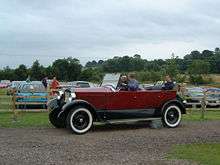 1923 Stanley steam car
1923 Stanley steam car A Stanley Steamer in 1903 setting a record mile at the Daytona Beach Road Course
A Stanley Steamer in 1903 setting a record mile at the Daytona Beach Road Course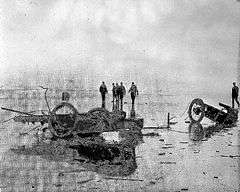 The demolished "Rocket" Stanley Steamer (1907)
The demolished "Rocket" Stanley Steamer (1907) World Speed Record Stanley Steamer, 1906, Wrecked 1907)
World Speed Record Stanley Steamer, 1906, Wrecked 1907)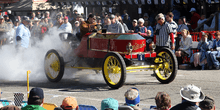 A 1908 Stanley preparing to race at the Newport Antique Auto Hill Climb in Newport, Indiana
A 1908 Stanley preparing to race at the Newport Antique Auto Hill Climb in Newport, Indiana- Stanley 30 HP 12-passenger Mountain Wagon (1912–1914) in Germany
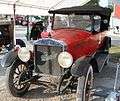
See also
- Mobile Company of America, which had originally purchased the Stanley brothers' factory and steam engine patents, but sold them back in 1903
- Steam car
- Steam engine
- Timeline of steam power
- History of steam road vehicles
Notes
- ↑ G.N. Georgano Cars: Early and Vintage, 1886–1930. (London: Grange-Universal, 1985).
- 1 2 CHRISTOPHER JENSEN (June 17, 2011). "Taming a Mountain Road With Horses and Cars". The New York Times. Retrieved September 29, 2011.
That was the day that F. O. Stanley and his wife, Flora, decided it would be good publicity for their steam-powered Stanley Locomobile if it were the first car to be driven up the 7.6-mile Mount Washington Carriage Road.
- ↑ Schematic of stanley steamer
- ↑ Stanley Steam Cars, The Automotor Journal, Nov 30th, 1912, p1444
- ↑ Glaskin, Max, Steam-powered car breaks century-old speed record, August 25, 2009, retrieved August 26, 2009
- ↑ British Steam Car Challenge
- ↑ "Stanley Steamer – General Information". www.stanleymotorcarriage.com. Retrieved April 3, 2010.
- ↑ 'Stanley Steamer' tourer steam driven motor car, 1920s, National Museum of Australia
- 1 2 Federal Reserve Bank of Minneapolis Community Development Project. "Consumer Price Index (estimate) 1800–". Federal Reserve Bank of Minneapolis. Retrieved October 21, 2016.
- ^ Stanley Technical Information"
- ^ Stanley production specs"
- ^ Friends of Auburn Heights Preserve – FAQ"
Coordinates: 41°5′3″N 73°52′11″W / 41.08417°N 73.86972°W
External links
| Wikimedia Commons has media related to Stanley vehicles. |
- Stanley Steamers
- Museum web page on the Stanley Steamers in Kingfield, Maine
- Stanley Steamer – Technical Information
- World's largest active collection of Stanley Steamers
- Stanley Register Online – Worldwide register of existing Stanley steam cars
- British Steam Car Challenge 2008
- Videos: Stanley Steamers driven and explained by Jay Leno